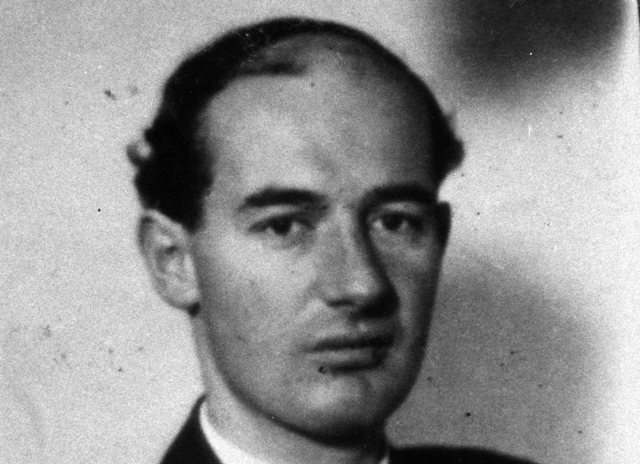The fate of Raoul Wallenberg, a Swedish diplomat who saved tens of thousands of Hungarian Jews during the Holocaust and mysteriously disappeared afterwards, has finally come to light after seven decades through the recently uncovered diaries of Ivan A. Serov, the first head of the notorious Soviet KGB service.
“I have no doubts that Wallenberg was liquidated in 1947,” Serov, who ran the KGB from 1954 to 1958, wrote in his journal.
Serov also recounts how Viktor Abakumov, his predecessor, revealed during an interrogation that the order to “liquidate” Wallenberg had come from Soviet leader Joseph Stalin and Vyacheslav M. Molotov, the foreign minister.
His diary also has remarks on Wallenberg’s cremation.
Serov also described reading a Wallenberg file.
The New York Times, which reported the full story on Sunday, wrote that Serov’s diaries were recently found hidden in a wall by his granddaughter.
Four years ago, Serov’s only grandchild, Vera Serova, 57, a retired ballet dancer, had the garage at the dacha she inherited from her grandfather in northwestern Moscow renovated. The workers demolishing the internal walls stumbled upon a few hidden suitcases. One of them contained the diary.
Wallenberg, who disappeared in 1945, was believed to have been arrested and imprisoned by the Soviets after the war.
They did so because they suspected he was spying on them because of his close ties with the US and Nazi leadership. They believed that his rescuing Jews was only an implausible cover story.
Clues of Wallenberg’s whereabouts emerged throughout the years. Alexandra M. Kollontai, the Soviet ambassador to Sweden, initially told Wallenberg’s mother that the diplomat was in custody, but backtracked after the Kremlin announced that it knew nothing of the case.
In the 1950s, Moscow began releasing war prisoners, and some reported meeting Wallenberg.
Sweden started asking questions and, seeking to improve ties, the Kremlin released a report in 1957. It said a newly discovered, partial medical report indicated that Wallenberg, age 34, died of a heart attack in prison in July 1947 — a stock Soviet cover story.
In 1991, after the collapse of the Soviet Union, the Kremlin agreed to cooperate with a comprehensive Russian-Swedish effort that included archival research and interviews with retired state security employees, but the final report in 2000 reached no definitive conclusion about Wallenberg’s fate, and found that documents had been destroyed or altered to eliminate all traces of him.
“There should have been a personal or prisoner file which was created for every prisoner,” said Hans Magnusson, a retired senior diplomat who directed the Swedish side of the Swedish-Russian Working Group. “The Russians said that they did not find one.”
In the half-dozen pages devoted to the Wallenberg case, Serov said Nikita S. Khrushchev, who succeeded Stalin as Soviet leader, had asked him to investigate what happened and respond to Sweden. Serov wrote that he ultimately failed to uncover the full circumstances of Wallenberg’s death, and found no evidence that he had been a spy.
An Angel of Hope
Marie Dupuy, Wallenberg’s niece and heir to the effort to unearth the truth, said she would like to see the original diaries and ask the FSB, the successor agency to the KGB, for the documents mentioned by Serov. “Numerous questions remain about the source material, which must be thoroughly evaluated before any conclusions can be drawn,” Ms. Dupuy said.
Wallenberg, recognized by Israel in 1963 as a Righteous Among the Nations – a title bestowed upon gentiles who saved Jews in the Holocaust, saved Jews by issuing Swedish passports and protective letters to Jews who were otherwise doomed to deportation to the gas chambers in Auschwitz.
“During the dark days of horror and death, Wallenberg manifested himself as an angel of hope, issuing in three months thousands of protective letters to persecuted Jews. When Adolf Eichmann organized the death marches of thousands of Jews from Budapest to the Austrian border, Wallenberg pursued the convoys in his car and managed to release hundreds of Jews to whom protective letters were granted,” Yad Vashem, Israel national Holocaust memorial, writes.
By: United with Israel Staff
Do You Love Israel? Make a Donation - Show Your Support!
Donate to vital charities that help protect Israeli citizens and inspire millions around the world to support Israel too!
Now more than ever, Israel needs your help to fight and win the war -- including on the battlefield of public opinion.
Antisemitism, anti-Israel bias and boycotts are out of control. Israel's enemies are inciting terror and violence against innocent Israelis and Jews around the world. Help us fight back!
